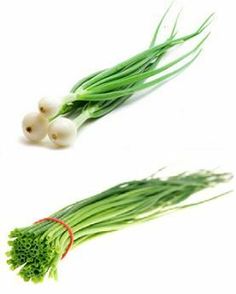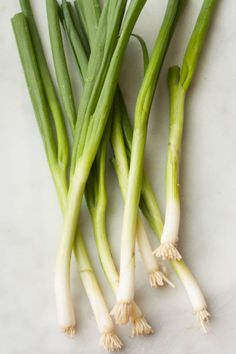Green Onion vs. Chives: What's the Difference?

Allium family members are shallots, scallions, garlic, leeks, chives, and green onions. Chives have a subtle onion-garlic taste and long, thin green stems. They also produce gorgeous purple blooms with a little onion-garlic taste.
That being stated, let’s take a deeper look at both chives and green onions to see what the distinctions are.
Chives

Green chives stems are frequently used as a garnish and in dressings, cream cheese, dips, salads, stews, sauces, and potato and egg dishes.
The petals may also be used as a garnish to add a lovely purple hue to various cuisines. Because chives have a mild flavor, they’re added towards the cooking process’s end to keep the flavor fresh and light.
Chives are available at stores, where they are offered in bunches. You must, however, keep them correctly because they do not last long.
Refrigerate them in a jar half-filled with water or wrapped in a paper towel inside a plastic zip-top bag to keep them fresh.
They’ll last 10-14 days in the fridge if you keep them dry and don’t let mildew grow on them.
Green Onions
Green onions are sometimes referred to as scallions or spring onions. Because green onions and scallions are not completely matured and have smaller bulbs than spring onions, they are all slightly different.
Green onions are distinguished by their long green stems and white bulbs. The tastes in both portions are distinct.
Green onions’ white section has a richer onion flavor than the green stalks, which offer a fresh, grassy flavor.
Green onions are versatile and may be used raw or cooked in various dishes. Stir-fries, salad dressings, marinades, dips, and sauces all benefit from them.
On the other hand, green onions function well in cooked recipes and are often added at the end of the cooking procedure to keep them crisp. Green onions are also delicious roasted or grilled or sprinkled on top of soups, rice, or potato puree as a garnish.
Put green onions in a glass container half filled with water to keep them fresh. Cleanse the green onions and insert the white pieces in the jar’s bottom. Put the onions in a plastic bag, wrap it with an elastic band around the jar, and store it in the fridge.
The green onions will last approximately a week in the refrigerator.
Wrapping green onions in paper towels is another technique to keep them fresh. To preserve green onions fresh for 3-4 days, clean them, blot dry with paper towels to eliminate excess water, then wrap them in paper towels.
What is the difference between Chives and Green Onions?

Although both onion family members, chives and green onions, have distinct characteristics, the first thing you’ll notice is their physical look.
Green onions have larger, thicker stems and white bulbs, whereas chives have long green and thin stalks and are smaller.
Chives are fragile and sensitive, so they’re generally eaten raw or cooked to preserve their lovely green color and mild flavor. On the other hand, green onions may be eaten raw or cooked and are a common element in various recipes.
Chives have a light onion-garlic flavor comparable to but not identical to green onion’s greener sections. Green onion white bulbs have a deeper onion taste and are commonly used in stir-fries, soups, and curries.
Key Differences
Chives
Appearance: Green stalks that are long and slender.
Consumption: Raw
Culinary Use: As a herb and seasoning.
Flavor: Onion taste is subtle with a trace of garlic.
Green Onion

Appearance: Green stalks that are longer, thicker, and broader, as well as the white bulbs
Consumption: Raw and cooked
Culinary Use: As a garnish and a cooking item
Flavor: The green stalks have a fresh-grassy onion flavor, while the white bulbs have richer.
Chives and Green Onion —Nutrition
Green onions and chives are high in vitamins, minerals, and antioxidants. They are, nevertheless, low in calories, making them a nutritious component that can be utilized in a variety of cuisines.
According to the USDA, chives include vitamins A, C, and K and calcium, potassium, magnesium, phosphorus, and folate. On the other hand, green onions are high in folate, protein, magnesium, potassium, sodium, iron, selenium, and vitamins A, C, K, E, and B3.
Chives vs Green Onion for Baked Potatoes
Baked potatoes are a flexible side dish that goes well with steaks, chicken, pork chops, meatloaf, grilled meat, grilled portobello mushrooms, and other entrees. Nevertheless, butter, cream cheese, parmesan, parsley, chives, and green onions work wonderfully as a garnish.
To garnish your baked potatoes, cut chives or green onion and place onto
To garnish your baked potatoes, cut chives or green onion, and place on which one you use will determine the flavor you desire.
Use the finely diced stems of the green onions if you want a greater onion taste in your baked potatoes. If you want a lighter onion flavor, sprinkle chopped chives on your baked potatoes.
Due to their inexpensive cost, green onions are frequently used as a garnish for baked potatoes in restaurants. They’re also easier to work with than chives.
Green onions can also be used as a topping in chives, but only in tiny quantities and sliced into little bits. You’ll escape the pungent onion flavor that comes with them this way.
Related Questions
- Can I replace green onions with chives?
Green onions can be replaced with chives.
However, because they have a gentler flavor than green onions, you will need to use more of them to get a flavor comparable to green onions.
You may substitute 2-3 tablespoons of diced chives for one medium green onion.
- Chives or Green Onions: Which is Better?
They both taste great, and which one you use depends on the food you’re making and the flavor you’re going for.
Use chives as a garnish if you want a light onion flavor. Green onions, on the other hand, have a greater onion flavor.
They may be used raw or cooked in salads, stir-fries, or as a garnish on soup, rice, or other prepared food.
- Do Chives Have an Onion Flavor?
Chives have an onion-like flavor, although they are milder than normal onions. Their taste is similar to onions with a dash of garlic. Chives are finest tossed over vegetables, creamy sauces, grilled meats, and fish when they’re fresh cut.
- What’s the Difference Between Chives and Scallions?
In many respects, chives and scallions are unlike.
They are distinct in appearance, flavor, and application. Chives are used as a garnish and feature long green stalks with a subtle onion-garlic taste.
Scallions are green onions with white bulbs and broad green stems. They also have a richer onion taste than chives and are used in various dishes, both fresh and cooked.
- Why are Chives so costly?
Chives are expensive due to their delicate texture. Furthermore, if they are not maintained properly, they can rapidly deteriorate. You should not buy or use chives if they have a terrible odor, a soft texture, a pale green hue, or are wilted.











